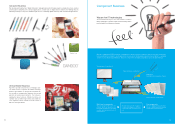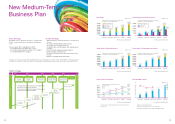Wacom 2013 Annual Report Download - page 17
Download and view the complete annual report
Please find page 17 of the 2013 Wacom annual report below. You can navigate through the pages in the report by either clicking on the pages listed below, or by using the keyword search tool below to find specific information within the annual report.
32
March 31
2013
March 31
2013
Thousands of
U.S. dollars
Thousands of yen
Amount of overdraft limit
Utilized overdraft facilities
Net amount
¥2,000,000
-
¥2,000,000
¥2,000,000
-
¥2,000,000
$21,265
-
$21,265
March 31
2012
March 31
2013
March 31
2013
Thousands of
U.S. dollars
Thousands of yen
Notes receivable
Notes payable
¥1,900
118,622
¥28,316
87,531
March 31
2012
(1) Cost of sales -
Gain on reversal of loss on valuation of inventory
which is included in cost of sales for the years ended
March 31, 2012 and 2013 were ¥16,859 thousand and
¥9,528 thousand ($101 thousand), respectively.
(2) Selling, general and administrative expenses -
The major components of “Selling, general and
administrative expenses” are as follows:
(3) Research and development expenditures -
Research and development expenditures are included
in selling, general and administrative expenses. Such
expenses amounted to ¥1,842,439 thousand and
¥2,382,424 thousand ($25,331 thousand) for the years
ended March 31, 2012 and 2013, respectively.
(4) Gain on sales of noncurrent assets -
(5) Loss on sales of noncurrent assets -
(6) Loss on retirement of noncurrent assets -
Notes to Consolidated Financial Statements
$301
931
(Consolidated statements of income)
Previously, freight cost for shipping to the customers
was recognized as “Cost of sales” by some overseas
subsidiaries, however it has been recognized as “Sell-
ing, general and administrative expenses” in the year
ended March 31, 2013.
Due to the acceleration of overseas expansion, inte-
grated decision making and management at the
global level, this change has been made to standard-
ize the scope of cost of sales amount of the Company
and its subsidiaries, and to pursue performance man-
agement more precisely.
As a result, ¥145,057 thousand which was included in
“Cost of sales” was reclassified to “Selling, general
and administrative expenses” in the consolidated
statements of income for the year ended March 31,
2012.
6. Consolidated balance sheets:
Information regarding the consolidated balance
sheets as of March 31, 2012 and 2013 is as follows.
(1) Overdraft facility -
For effective funding to meet working capital require-
ments, the Company has established overdraft facili-
ties with two banks. Unutilized overdraft facilities
under these contracts as of March 31, 2012 and 2013
were as follows:
(2) Notes maturing as of the fiscal year end -
Notes maturing as of the fiscal year end are settled on
the clearance date. Therefore, the following notes
which matured as of the fiscal year end have been
included in the fiscal year end consolidated balance
sheets due to the holiday of financial institutions.
7. Consolidated statements of income:
Information regarding consolidated statements of
income for the years ended March 31, 2012 and 2013
is as follows.
Thousands of
U.S. dollars
Thousands of yen
Salaries
Research and development
expenses
Advertising expenses
Pension expenses
Provision for bonuses
Provision for directors’ and
statutory corporate auditors’
bonuses
Provision for allowance for
doubtful accounts
¥3,119,079
1,842,439
1,311,355
102,708
450,755
87,595
3,094
¥3,606,071
2,382,424
1,652,102
80,838
682,389
163,365
4,069
Year ended
March 31, 2012
$38,342
25,331
17,566
860
7,256
1,737
43
Year ended
March 31, 2013
Year ended
March 31, 2013
Year ended
March 31, 2013
Year ended
March 31, 2013
Thousands of
U.S. dollars
Thousands of yen
¥792
1,265
0
¥2,057
¥1,636
167
-
¥1,803
$17
2
-
$19
Year ended
March 31, 2012
Machinery, equipment and vehicles
Tools, furniture and fixtures
Other intangible assets
Total
Year ended
March 31, 2013
Year ended
March 31, 2013
Thousands of
U.S. dollars
Thousands of yen
Machinery, equipment and vehicles
Tools, furniture and fixtures
Total
¥1,283
54
¥1,337
¥1,475
372
¥1,847
$16
4
$20
Year ended
March 31, 2012
Year ended
March 31, 2013
Year ended
March 31, 2013
Thousands of
U.S. dollars
Thousands of yen
¥217
648
3,072
6,814
¥10,751
¥371
575
2,910
10,333
¥14,189
$4
6
31
110
$151
Year ended
March 31, 2012
Buildings and structures
Machinery, equipment and vehicles
Tools, furniture and fixtures
Other intangible assets
Total
31
cies are included in the consolidated statements of
income. All assets and liabilities are translated using
the current exchange rates at the respective balance
sheet dates and all income and expense accounts of
those subsidiaries are translated using the average
exchange rate for the fiscal year then ended. Foreign
currency translation adjustments resulting from such
procedures are recorded in the consolidated balance
sheets as a separate component of net assets.
(6) Amortization of goodwill -
Goodwill is amortized on a straight-line basis over its
remaining useful life.
(7) Cash and cash equivalents -
Cash and cash equivalents include all highly liquid
investments, generally with original maturities of three
months or less that are readily convertible to known
amounts of cash and, present an insignificant risk of
changes in value.
(8) Consumption taxes -
The consumption tax withheld upon sale and con-
sumption tax paid by the Companies on their pur-
chases of goods and services is not included in rev-
enue and cost or expense items in the accompanying
consolidated statements of income.
3. Changes in accounting policies:
Change in accounting principles and policies for the
year ended March 31, 2013 is as follows.
(Changes in accounting policy which are difficult to be
distinguished from changes in accounting estimates)
Changes in depreciation method:
The Company has changed the method of deprecia-
tion of property, plant and equipment to the straight-
line method from declining-balance method
(depreciation of buildings, except for equipment
attached to buildings, acquired by the Company after
April 1, 1998 was computed using the straight-line
method of depreciation) from the beginning of fiscal
year ended March 31, 2013. This change was made
due to the completion of transformation to a company
without fabrication facilities including its systems, the
Company's main functions have shifted from manu-
facturing to group management, and to reflect the fact
a large portion of property, plant and equipment have
been stably utilized. In addition, we have considered
the international harmonization of accounting treat-
ment and standardization of group accounting
policies, and concluded that the straight-line method,
which equalizes the periodic recognition of deprecia-
tion, more appropriately reflected the economic reality
of use of the assets over their life.
As a result, compared with the previous method, in
consolidated statements of income for the year ended
March 31, 2013, operating income, ordinary income
and income before income taxes increased by
¥288,576 thousand ($3,068 thousand), respectively.
4. New accounting standards and guidance
issued but not yet applied:
The new accounting standards and guidance issued
but which the Company has not yet applied as of
March 31, 2013 is as follows.
“Accounting Standards for Retirement Benefits”
(Accounting Standards Board of Japan Statement No.
26 issued on May 17, 2012) and “Guidance on Ac-
counting Standards for Retirement Benefits”
(Accounting Standards Board of Japan Guidance No.
25 issued on May 17, 2012)
1) Outline
The accounting standard and guidance were
amended such that actuarial gains and losses and
past service cost would be recognized within the Net
assets section in consolidated balance sheets after
adjusting for the tax effect, and the difference
between the retirement benefit obligation and plan
assets would be recognized as a liability or asset. Ad-
ditional changes from the new accounting standard
were the allowance of the benefit method basis in
addition the straight-line in the calculation of the peri-
odic benefit expense and the revision of the calcula-
tion method of the discount rate.
2) Scheduled date of application
The standard and the guidance will be applied from
the ends of fiscal year ending March 31, 2014. How-
ever, the amendments relating to determination of the
retirement benefit obligation and service cost will be
applied from beginning of the fiscal year beginning
April 1, 2014.
3) Impact on application of the accounting standard
and guidance
The Company is currently evaluating the potential
impact of this guidance on the consolidated financial
statements.
5. Changes in presentation methods:
Change in presentation methods for the year ended
March 31, 2013 is as follows.
(Consolidated balance sheets)
“Accounts receivable-other” , which was included in
“Others” under current assets in the year ended
March 31, 2012, has been presented separately in the
year ended March 31, 2013 as its significance to the
consolidated balance sheets has increased to be
greater than 5% of total assets. To reflect this change,
the financial statements for the year ended March 31,
2012 have been reclassified. As a result, ¥2,176,394
thousand of “Others” has been reclassified to
¥1,521,961 thousand of “Accounts receivable-other”
and ¥654,433 thousand of “Others” under current
assets in the consolidated balance sheets for the year
ended March 31, 2012.
“Software” , which was presented separately under
intangible assets in the year ended March 31, 2012,
was included in “Others” in the year ended March 31,
2013 as its significance to the consolidated balance
sheets has decreased. To reflect this change, the
financial statements for the year ended March 31,
2012 have been reclassified. As a result, ¥1,900,296
thousand of “Software” is reclassified to “Others”
under intangible assets in the consolidated balance
sheets for the year ended March 31, 2012.





















